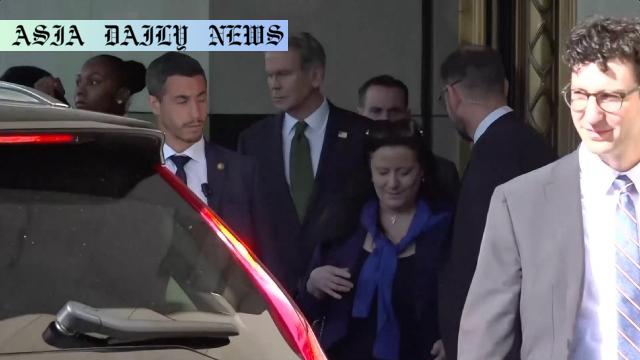Trade Talks: The US and China engage in their second day of high-level negotiations aimed at easing tariff tensions in Switzerland.
US and Chinese officials initiate the second day of negotiations in Switzerland.
The primary focus includes easing high tariffs between the two nations to foster better economic relations.
US President Trump hailed the first day of talks as making ‘GREAT PROGRESS.’
Both sides address tense trade relations, but Beijing remains firm on its stance against Washington’s tariffs.

Introduction: The Context of US-China Trade Talks
As the world’s two largest economies, the United States and China carry a significant responsibility to maintain stability in global trade. Over the past few years, trade tensions have escalated between these superpowers, with each imposing steep tariffs of over 100 percent on each other’s goods. This hostile trade environment has slowed international commerce and strained bilateral relations. On Sunday, key trade representatives from both countries convened in Switzerland for the second day of high-level discussions, aiming to ease these tariffs and reset their economic relationship.
Recap of Day One: Achieving Preliminary Success
US President Donald Trump commended the first day of discussions, emphasizing a productive atmosphere and significant agreements that could pave the way for a stronger trade partnership. He described the negotiations as “friendly but constructive,” and expressed optimism that China could open its doors to American businesses even further. This public declaration of progress underscores the strategic importance of these talks for both nations, especially as they grapple with domestic economic challenges heightened by the ongoing trade dispute.
The Key Players and Their Objectives
Leading the negotiations are some of the most prominent names in trade and economic policy. US Treasury Secretary Scott Bessent and Trade Representative Jamieson Greer are representing American interests, while Vice Premier He Lifeng, overseeing China’s economic policies, speaks for Beijing. Both sides aim to address issues such as tariff reductions, access to local markets, and intellectual property rights. However, Beijing has expressed resistance to what it perceives as coercive measures by Washington, making compromise a complex and delicate process.
Beijing’s Determination Against Tariff Policies
China has steadfastly opposed the high tariffs imposed by the US, citing them as unfair and detrimental to its economic sovereignty. Beijing’s approach to these negotiations reflects a balance between maintaining national interests and engaging in constructive dialogue. While willing to discuss market openings and trade agreements, the Chinese government has made it clear that it will not accept punitive tariffs without significant concessions from Washington. This stance highlights the difficulty of resolving entrenched trade disputes but also showcases China’s determination to stand firm on its economic strategies.
Trump’s Optimism and the Path Forward
President Trump has hinted at the possibility of reducing additional tariffs on Chinese goods, suggesting flexibility depending on the progress of these talks. He has repeatedly stated the need for fair trade practices and a balanced relationship that benefits both nations. A “total reset,” as Trump described, could redefine the economic landscape not only for the US and China but also for global markets. As negotiations continue, the path forward remains uncertain, but optimism from both parties indicates a shared willingness to work towards mutual benefit.
Conclusion: The Global Implications of the Talks
The outcomes of these discussions have the potential to reverberate across global economies. A resolution could ease supply chain constraints, lower consumer prices, and restore confidence in international trade systems. However, failure to reach an agreement could further entrench economic divides and exacerbate tensions. As the talks progress, the world watches closely, awaiting decisions that could shape the future of global commerce and diplomacy.



Commentary
Understanding the Nuances of the US-China Trade Dialogue
The ongoing trade talks between the United States and China are not just about tariffs and exports; they are a reflection of the broader complexities of bilateral relations between two powerful nations. These discussions highlight the delicate balance of power, economic interests, and political will that both countries must navigate to find a path forward. As observers, it is vital to understand the larger implications these talks hold, not only for these two economies but also for the global community. The question remains: can these economic giants find common ground, or will the strained relations persist?
Optimism and Skepticism in Equal Measure
President Trump’s declaration of “great progress” may instill hope, but it is only one side of the narrative. Beijing’s firm stance against yielding to US tariffs adds a layer of complexity that cannot be ignored. It is clear that while progress may be made on certain fronts, resolving years of tension and mistrust will require more than a few days of negotiation. This skepticism reminds us that substantive change takes time and effort, and the immediate announcements should be viewed through a lens of cautious optimism.
The Ripple Effects on Global Economies
Beyond the bilateral impacts, the results of these talks could influence global markets, trade flows, and economic stability. A resolution could pave the way for reduced costs in supply chains and improved trade dynamics worldwide. On the flip side, a failure to reach an agreement may exacerbate protectionist policies and fuel uncertainties in international trade. For businesses, governments, and individuals, the stakes are high, and the outcomes will undoubtedly shape the near future of global economic interactions.
Looking to the Future
The US-China trade talks illustrate the intricate interplay of politics, economics, and diplomacy, and serve as a reminder of the importance of measured negotiation. It is imperative that both sides approach these discussions with mutual respect and a willingness to compromise. While the path ahead may be fraught with challenges, the potential benefits of a comprehensive agreement underscore the necessity of continued dialogue. The world will be watching closely, and the results of these high-level talks could set a precedent for how nations approach complex economic disputes in the years to come.